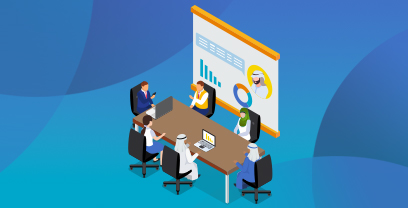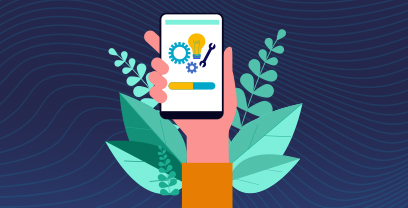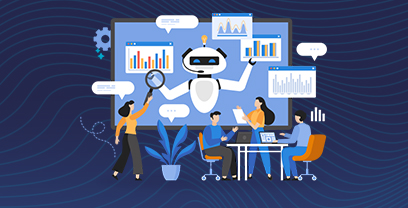Introduction
In today’s business landscape, the success of an organization is defined by its efficiency and strategic edge. Within this context, the procurement function plays a crucial role in driving innovation and process optimization.
Gone are the days when procurement was viewed as merely a transactional activity; today, it stands at the forefront of driving operational excellence and gaining a competitive advantage.
It’s important to note that in 2023, high inflation made finding ways to save money a top priority for 46% of CPOs. Amidst this transformative landscape, automating procurement processes has become essential to navigate the increasing complexities of modern procurement, while helping organizations contain costs.
In this blog, we will review everything you need to know about the procurement process, types of procurement, best practices in procurement optimization, and how Ivalua’s procurement platform can modernize how organizations approach procurement in the digital age.
So, we ask: What is a Procurement Process?
The procurement process consists of all of the activities or steps involved in acquiring goods and services from external sources. Including identifying needs, sourcing suppliers, negotiating terms,onboarding suppliers, purchasing goods, receiving and inspecting goods, and managing invoices, payments, and relationships with suppliers.
The procurement process is critical to the broader procurement lifecycle, which ensures that an organization can secure the best possible value from its external suppliers.
The procurement process is vital for several reasons:
- Cost Efficiency: It helps organizations obtain the best prices and terms for the goods and services they require, controlling costs and maximizing budget efficiency.
- Quality Assurance: Through careful supplier selection and management, organizations can ensure they receive high-quality goods and services, meeting their standards and requirements.
- Risk Management: The process allows organizations to identify, assess, and mitigate risks associated with supplier reliability, contractual obligations, and market changes.
- Strategic Sourcing: It enables strategic decisions about sourcing, helping organizations develop long-term relationships with suppliers, secure supply chains, and adapt to market dynamics.
- Compliance and Transparency: A structured procurement process ensures compliance with laws and regulations, promotes transparency, and supports ethical business practices.
Within the procurement process, two critical sub processes are:
- Source-to-Contract (S2C): S2C focuses on strategic procurement aspects, establishing the framework for spend analysis, supplier selection, supplier risk and performance management, negotiations, and contract management, to ensure favorable terms and conditions for the organization.
- Procure-to-Pay (P2P): P2P is concerned with operational procurement, including ordering, receiving, and paying for goods and services. It emphasizes operational efficiency, inventory management, accuracy in order fulfillment, and effective payment processes.
Both S2C and P2P are integral to the procurement cycle, contributing to an organization’s overall procurement strategy by enhancing efficiency, reducing costs, and ensuring the effective acquisition of goods and services.
Check out our blog post, “eSourcing: A Guide to Digital Procurement.”
The Three Main Spend Areas Where Procurement Processes Differ?
The procurement process can be categorized into three distinct phases based on the nature of the purchase:
- Indirect Procurement: Indirect Procurement pertains to purchasing goods and services that support the operations of the organization but are not part of the finished product. This includes office supplies, maintenance services, software, and utilities, among others. Although indirect procurement may not directly contribute to production, it’s crucial for the smooth functioning of the business. Managing costs while ensuring quality and reliability is key, often requiring a broad base of suppliers and efficient order and inventory management to prevent operational disruptions.
- Services Procurement: Services Procurement largely mostly part of indirect procurement is the process of obtaining services rather than goods from external suppliers. This can range from hiring consultants, legal services, cleaning, to IT support. Services procurement poses unique challenges, such as defining the scope of work, measuring service quality, and managing supplier relationships. Contracts often include service level agreements (SLAs) to define expectations clearly. The focus is on maximizing value by carefully selecting suppliers who can meet the organization’s needs reliably and cost-effectively.
- Direct Procurement: Direct Procurement involves acquiring raw materials and goods necessary for manufacturing products. This type of procurement is directly tied to the production process of an organization and has a direct impact on its bottom line. The main goal here is to secure the best possible cost, quality, and reliability of supplies to ensure uninterrupted production and maintain product quality standards. Relationships with suppliers are often long-term, focusing on supply chain stability, volume discounts, and strategic partnerships.
Each of these procurement process phases plays a vital role in the operational and financial efficiency of an organization. They require distinct strategies and management approaches to address their specific challenges and opportunities effectively.
What Are the Primary Types of Procurement Organizational Models?
The procurement process is a critical component of any organization’s operations, serving as the central “hub” for securing the goods and services necessary for business continuity. The flow and structure of this process can vary significantly, reflecting the organization’s unique characteristics such as its size, complexity, and strategic demands. Here, we outline four prevalent models that organizations might employ:
Centralized Procurement
In a centralized procurement model, all purchasing activities are managed by a single, central department within the organization. This approach allows for greater control over the procurement process, enabling standardized procedures, consolidated purchasing, and volume discounts.
Centralized procurement can lead to significant cost savings, improved negotiation power with suppliers, and a more consistent approach to supplier management and contract negotiations. However, it may also result in slower response times to department-specific needs and a potential disconnect between the central procurement team and individual departments or business units.
Decentralized Procurement
Decentralized procurement allows individual departments or business units within an organization to make their own purchasing decisions and manage their own procurement processes. This approach offers flexibility and agility, enabling departments to respond quickly to their specific needs and market changes, which can foster innovation and better alignment with departmental goals.
However, it may lead to inconsistencies in purchasing practices, missed opportunities for bulk purchasing discounts, and a lack of standardized supplier management across the organization.
Learn more about Decentralized procurement modernization in our Covéa Case Study.
Procurement Outsourcing
Procurement outsourcing involves contracting with external service providers to manage all or part of an organization’s procurement functions. This can include strategic sourcing, transaction management, supplier management, and procurement software solutions. Outsourcing procurement can allow organizations to benefit from the expertise, technology, and economies of scale offered by specialized providers, leading to cost reductions, efficiency improvements, and the ability to focus on core business activities.
However, it requires careful selection of partners, clear service level agreements (SLAs), and effective communication to ensure alignment with business goals. Potential drawbacks include loss of control over the procurement process and reliance on external providers.
Hybrid Procurement
A hybrid procurement model combines elements of both centralized and decentralized procurement. This approach allows organizations to leverage the benefits of centralized control and oversight for key categories or strategic purchases while enabling individual departments or business units to make decisions on less critical or more specialized purchases.
The hybrid procurement model aims to balance efficiency and agility, optimizing procurement outcomes based on the nature of the spend and organizational structure.
What Are the 7 Procurement Process Steps?
The procurement process is a comprehensive series of steps that organizations follow to acquire goods and services needed to conduct their operations. The table below describes the seven key procurement process steps.
| Steps | Description |
| Need Identification / Requirements Planning | Recognizing a need within the organization and precisely defining the requirements for the goods or services, specifying quantities, standards, and timelines |
| Submit a Purchase Request | Submitting a formal purchase request detailing the specifications, quantity, and desired delivery timeframe of the goods or services required |
| Vendor Selection / Supplier Selection with RFQ | Soliciting bids from potential suppliers through a Request for Quotation (RFQ) or other sourcing methods; evaluating vendors based on price, quality, reliability, and capacity to meet the organization’s needs |
| Contract Negotiation | Negotiating price, terms, delivery schedules, and other contract specifics take place, to reach an agreement that offers the best value and minimizes risks for the organization |
| Create Purchase Requisition and Purchase Order | Formally approving the purchase requisition, and creating a purchase order (PO) for the supplier that serves as an official offer to buy the products or services under the agreed-upon terms |
| Receipt of Goods or Services | Checking received goods against the PO and specifications to ensure everything is received as agreed, and addressing any discrepancies with the supplier |
| Invoice Matching, Approval, and Payment Processing | Matching the supplier’s invoice with the PO and delivery documentation to verify accuracy, then processing payment to complete the procurement cycle |
What Are the 3 Ps in the Procurement Process?
The table below breaks down the three pillars of Procurement: People, Process, and Paperwork. Together, these three P’s form the cornerstone of a successful procurement operation, each contributing to the system’s overall efficiency, compliance, and effectiveness.
| Pillar | Description |
| People | Everyone involved in the procurement cycle, from the procurement team and other internal stakeholders to suppliers and vendors. This pillar emphasizes the importance of relationships, skills, communication, and collaboration in achieving procurement goals. |
| Process | The set of steps and procedures that guide the procurement of goods and services. A well-defined and streamlined process helps in achieving efficiency, transparency, and compliance. It includes procurement stages like need identification, vendor selection and vendor procurement process, negotiation, and payment. |
| Paperwork | All of the documents and records used and generated throughout the procurement process. This includes purchase requests, RFQs/RFPs, contracts, purchase orders, delivery receipts, and invoices. Effective management of paperwork ensures accuracy, compliance, and traceability. |
Overcoming Common Challenges in Procurement
We know that procurement departments play a critical role in ensuring the efficient and cost-effective acquisition of goods and services within organizations. However, they often face a range of challenges that can hinder their operations and impact overall business performance, such as:
- Disconnected Systems: Struggling with disparate software systems and manual processes that don’t communicate effectively, leading to inefficiencies and errors in procurement operations.
- No Supplier Relationships: Lack of strategic relationships with suppliers, resulting in missed opportunities for better terms, improved quality, and innovation due to a transactional rather than collaborative approach.
- No Visibility into Spending and Maverick Spending: Difficulty in tracking and controlling overall procurement spending, compounded by unauthorized or non-compliant purchasing that bypasses established procurement procedures.
- Poor Supply Chain Transparency: Challenges in gaining a clear understanding of the supply chain procurement process, including the origins of materials and the practices of suppliers, which can affect risk management and ethical sourcing efforts.
- Inaccurate Data: Dealing with data inaccuracies in inventory levels, supplier performance, and spending, which hinder effective decision-making and procurement planning.
Let’s explore the benefits, challenges and steps to implementing business spend management, in our blog “From Procurement to Profitability: Mastering Business Spend Management.
Best Practices for Optimizing Your Procurement Process
Adopting best practices in procurement is essential for organizations aiming to enhance efficiency, reduce costs, and strengthen their supply chain. Together, these best practices enable organizations to create a more responsive, efficient, and strategic procurement function, leveraging technology to gain insights and control over procurement activities and ensure that procurement contributes to the organization’s overall strategic objectives.
Automate Procurement Processes with Generative AI
Generative AI in procurement automates and optimizes procurement tasks, from data analysis to supplier communication. This technology can generate insights, predict trends, and facilitate decision-making, improving efficiency and reducing errors by handling routine tasks and analyzing complex data sets to inform strategic decisions.
Implement Procurement Management Software
Procurement management software centralizes and streamlines the entire procurement process flow, from requisition to payment. Procurement software offers tools for strategic sourcing, e-procurement, contract management, and spend analysis, centralizing data and processes to improve transparency, control, and efficiency across the procurement lifecycle. It also helps to assess and manage supplier risk and improve supplier relationships.
And that’s not all. According to Alex Saric, Chief Marketing Officer of Ivalua, “Automation of manual, transactional activity does not just improve operational efficiency, it also freezes capacity for more strategic tasks and deeper analysis.”
Evaluate Supplier Performance
Regularly assessing supplier performance against set criteria such as quality, delivery, price, and service ensures that suppliers meet the organization’s standards and expectations. This practice helps identify areas for improvement, foster supplier development, and mitigate risks, ensuring a reliable and competitive supply base.
Conduct Spend Analysis to Increase Spend Visibility and Reduce Maverick Spending
Spend analysis involves systematically reviewing procurement data to understand spending patterns, identify savings opportunities, and ensure compliance with procurement policies. By increasing spend visibility, organizations can strategically manage their procurement spend, negotiate better terms, consolidate suppliers, and reduce maverick spending (unmanaged or off-contract spending), which can undermine procurement strategies and inflate costs.
Case Study: How TransAlta Digitally Transformed their Procurement Processes to Drive Transparency, Productivity & Savings
With approximately $3 billion in annual revenue and power plants in Canada, the United States, and Australia, TransAlta was looking for a solution to help them with multiple challenges, including a greenfield implementation of strategic sourcing software.
The procurement team, which had limited digital and change management experience, needed help with overcoming manual solutions and defining new procurement processes from scratch. Significant integrations were required, including multiple SAP interfaces and seven interfaces with Docusign.
After implementing Ivalua’s Source-to-Pay platform, TransAlta was able to accelerate its contract approval process from days to just hours. They digitized over 250 contracts for improved spend visibility and onboarded over 3,600 suppliers for contract placement and sourcing events. What’s more, they are now able to execute more than 70 strategic and spot sourcing events per month.
Read the full TransAlta procurement modernization case study to learn more.
Automate Your Procurement Processes with Ivalua’s Unified Procurement Platform
Ivalua’s Procurement platform revolutionizes procurement processes by offering a comprehensive suite of tools designed for automation, efficiency, and strategic sourcing. By integrating various procurement activities into one cohesive system, Ivalua enables organizations to streamline operations, from vendor selection to final payment, reducing manual tasks, accelerating procurement cycles, and minimizing errors.
Ivalua provides unparalleled visibility into organizational spending and enhances control over procurement activities, as well. Its advanced spend analysis tools allow for real-time tracking and analysis of procurement data, enabling informed decision-making and strategic spend management.
Watch a demo of Ivalua’s S2P platform to see how organizations can optimize procurement practices, improve supplier management and compliance, and maintain a competitive edge, all while ensuring cost savings and maximizing value from their procurement operations.
Conclusion
Revolutionizing procurement operations is pivotal for organizations aiming to elevate operational efficiency, secure a competitive edge, and exercise precise spending oversight. At the heart of this transformation lies the integration of cutting-edge solutions such as the Ivalua Source-to-Pay platform. This robust suite is meticulously engineered to automate workflows, refine procurement processes, and illuminate every facet of an organization’s purchasing activities.
The adoption of Ivalua’s strategic sourcing software empowers organizations to transcend routine tasks, thereby redirecting focus toward higher-level strategy formation. Not only does this enable more impactful decision-making, but it also cultivates more robust supplier partnerships. By ensuring adherence to compliance standards and driving substantial cost reductions, Ivalua positions organizations to not just succeed, but to redefine the benchmarks of procurement excellence.
Discover the potential of Ivalua’s end-to-end Source-to-Pay (S2P) platform and take the first step towards transforming your procurement process today!




